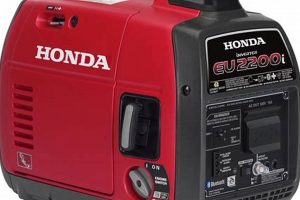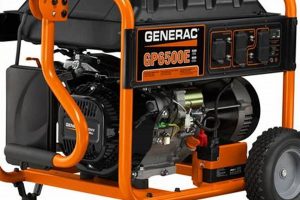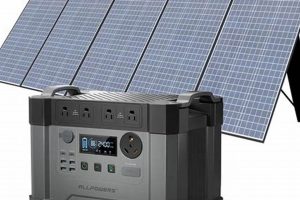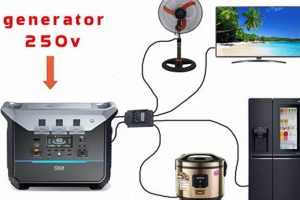Retailer Lowe’s offers a selection of mobile power sources designed for residential use. These units provide temporary electrical power during outages caused by storms, grid failures, or other disruptions. They vary in power output, fuel type (gasoline, propane, or dual-fuel), and features, catering to diverse needs from powering essential appliances to running entire homes.
Backup power supplies offer crucial support during emergencies, ensuring the continued operation of refrigerators, sump pumps, medical equipment, and communication devices. Having access to electricity can maintain safety, comfort, and prevent property damage during extended power loss. The development and availability of increasingly portable and affordable generators have made home backup power a more accessible solution for disaster preparedness.
Further exploration of this topic will cover specific generator types, selection criteria, safety procedures, maintenance requirements, and potential cost considerations. This information will empower consumers to make informed decisions when choosing a suitable backup power solution.
Tips for Selecting and Operating a Portable Generator
Careful consideration and planning are essential when choosing and using a portable generator. The following tips provide guidance for safe and effective operation.
Tip 1: Accurate Power Assessment: Determine the wattage requirements of appliances intended for backup power. This information informs the appropriate generator size. Overloading a generator can damage both the unit and connected devices.
Tip 2: Fuel Type Considerations: Evaluate available fuel options (gasoline, propane, dual-fuel) based on accessibility, storage capacity, and individual needs. Propane offers longer shelf life while gasoline may be more readily available in certain situations.
Tip 3: Safe Placement: Operate generators outdoors in well-ventilated areas, away from windows and doors. Carbon monoxide poisoning is a serious hazard associated with improper generator placement.
Tip 4: Transfer Switch Installation: A professionally installed transfer switch is the safest method for connecting a generator to a home’s electrical system. This prevents backfeeding, which poses a danger to utility workers.
Tip 5: Routine Maintenance: Regular maintenance, including oil changes and filter replacements, is crucial for optimal generator performance and longevity. Consult the manufacturer’s guidelines for specific maintenance schedules.
Tip 6: Proper Storage: Store fuel and generators safely, following manufacturer recommendations and local regulations. Fuel should be stored in approved containers in well-ventilated locations.
Tip 7: Pre-Purchase Research: Consult reviews, compare models, and research reputable brands before making a purchase. Consider factors like runtime, noise level, and available features.
Adhering to these guidelines ensures safe and efficient generator operation, providing reliable backup power during outages. Informed decision-making and proactive planning are key to successful generator use.
Equipped with these practical tips, consumers can proceed confidently towards selecting the most suitable generator for their individual needs. The subsequent sections will further detail specific product features and considerations.
1. Power Output
A crucial factor when selecting a portable generator from Lowe’s is its power output, measured in watts. This specification directly determines which appliances can be powered simultaneously and for how long. Understanding power output is essential for matching a generator to specific needs, preventing overload, and ensuring sufficient power during outages.
- Starting vs. Running Watts
Appliances require a surge of power to start, known as starting watts, which is higher than the power needed to continue running (running watts). Generators must accommodate both. For example, a refrigerator might require 2,000 starting watts but only 700 running watts. Lowe’s provides these specifications for each generator, enabling informed decisions.
- Total Power Needs Assessment
Calculating the combined wattage requirements of essential appliances is critical. Adding up the running watts of intended devices provides a baseline. Factor in the highest starting wattage of any single appliance to ensure the generator can handle the initial surge. This calculation prevents overloading and ensures adequate power supply.
- Generator Size and Power Output Correlation
Generators available at Lowe’s range in power output from a few thousand watts for basic needs to over 10,000 watts for whole-house coverage. Smaller generators are suitable for powering essential items like refrigerators and lights, while larger units can run air conditioners, sump pumps, and other high-wattage appliances. Choosing the right size based on power needs is critical.
- Impact on Runtime
Power output also influences runtime, the duration a generator can operate on a single tank of fuel. Higher power output typically results in shorter runtimes. Lowe’s provides runtime estimates for different load levels, allowing consumers to anticipate how long the generator will operate under specific conditions. This factor is crucial for extended outages.
By considering starting and running watts, calculating total power needs, correlating generator size with output, and understanding runtime implications, consumers can effectively select the appropriate generator from Lowe’s. This careful consideration ensures reliable power supply during outages, matching generator capabilities to individual requirements.
2. Fuel Type
Fuel type is a critical consideration when selecting a portable generator from Lowe’s. The choice of fuel directly impacts availability, storage requirements, runtime, and overall cost of operation. Understanding the advantages and disadvantages of each fuel type empowers informed decision-making.
Gasoline: Gasoline-powered generators are common due to fuel availability. Most gas stations carry gasoline, making refueling relatively easy during emergencies. However, gasoline has a limited shelf life and can degrade over time, potentially causing carburetor issues. Proper storage in approved containers and fuel stabilizer use are essential. Gasoline generators often offer higher power output options.
Propane: Propane offers a longer shelf life than gasoline, making it suitable for long-term storage. Propane generators tend to produce cleaner emissions and operate more quietly. Propane requires specific tanks and connections, and refilling or exchanging tanks may be less convenient than refueling with gasoline during widespread outages. Propane burns slower than gasoline resulting in potentially longer run times.
Dual Fuel: Dual-fuel generators offer flexibility, operating on either gasoline or propane. This versatility provides options depending on fuel availability and individual preferences. Dual-fuel generators can switch between fuel sources seamlessly, extending runtime during prolonged outages. This adaptability comes at a premium, often making dual-fuel models more expensive than single-fuel options.
The selection of a fuel type depends on individual circumstances and priorities. Accessibility, storage capacity, runtime needs, and budget constraints all influence the optimal choice. Careful evaluation of these factors ensures the chosen generator aligns with specific requirements. Understanding the nuances of each fuel type enhances the ability to select the appropriate power solution from Lowe’s inventory.
3. Portability
Portability is a defining characteristic of these generators, directly influencing their usability and suitability for various applications. The ease with which a generator can be moved and positioned significantly impacts its practicality during power outages and other scenarios. Analyzing the components of portability provides valuable insights for consumers.
- Weight and Size
The physical dimensions and weight of a generator dictate how easily it can be maneuvered and transported. Smaller, lighter units are ideal for single individuals or those with limited physical strength. Larger generators may require multiple people or assistive devices for movement. Lowe’s provides weight and dimension specifications for each model, facilitating informed comparisons.
- Wheels and Handles
Integrated wheels and handles significantly enhance portability. Larger wheels navigate uneven terrain more effectively, while ergonomically designed handles improve grip and control during transport. The presence and design of these features are essential considerations, particularly for heavier generators.
- Compact Design
A compact design minimizes storage space requirements when the generator is not in use. Foldable handles and other space-saving features contribute to efficient storage. This aspect is particularly relevant for individuals with limited storage capacity.
- Placement Flexibility
Portability enables flexible placement of the generator in safe, well-ventilated locations outdoors. This is crucial for preventing carbon monoxide buildup and ensuring safe operation. A portable unit can be positioned at a safe distance from the house while still providing power through extension cords.
Considering these facets of portabilityweight, size, maneuverability aids, compact design, and placement flexibilityempowers consumers to select a generator from Lowe’s that aligns with their physical capabilities and specific needs. A thorough evaluation of portability ensures the chosen generator can be readily deployed and positioned safely and effectively during a power outage.
4. Brand Selection
Brand selection significantly influences the quality, reliability, and features available in portable home generators sold at Lowe’s. Reputable brands often represent a history of manufacturing experience, technological innovation, and robust customer support. Choosing a recognized brand can offer advantages in terms of product durability, performance consistency, and access to warranty services. For example, a well-established brand like Generac is known for its focus on generator technology, while a brand like Honda is recognized for engine reliability. This distinction allows consumers to align their purchase with specific priorities.
Different brands offer varying features, technological implementations, and design philosophies. Some prioritize compact design and portability, while others focus on high power output and extended runtime. Examining the specific features offered by different brands within Lowe’s inventory enables consumers to match product capabilities to their individual needs. A homeowner prioritizing quiet operation might choose a brand known for low-noise generators, while another focusing on ease of use might select a brand offering user-friendly control panels and simplified maintenance procedures. Understanding these brand-specific nuances empowers informed decision-making.
Selecting a reputable brand often translates to better post-purchase support. Established brands typically provide comprehensive warranties, readily available parts, and accessible service networks. This support infrastructure can prove invaluable in the event of malfunctions or required maintenance. Access to readily available parts and qualified technicians can minimize downtime and extend the lifespan of the generator. Considering the long-term implications of brand selection, including warranty coverage and service availability, ensures a more satisfactory ownership experience.
5. Warranty & Support
Warranty and support services are essential considerations when purchasing a portable generator from Lowe’s. These provisions offer protection against manufacturing defects, performance issues, and unforeseen malfunctions. Understanding the scope and limitations of warranty coverage and the availability of technical support empowers consumers to make informed decisions and ensures long-term satisfaction with their purchase.
- Manufacturer’s Warranty
Portable generators typically come with a manufacturer’s warranty covering specific components and potential defects for a defined period. Warranty duration can range from one to five years, depending on the brand and model. Reviewing the warranty terms and conditions carefully before purchase clarifies coverage limitations and exclusions. For instance, some warranties may exclude coverage for damage caused by improper maintenance or fuel usage. Understanding these details is essential for maximizing warranty benefits.
- Extended Warranty Options
Lowe’s may offer extended warranty options, providing coverage beyond the manufacturer’s warranty period. These extended warranties can offer additional peace of mind, especially for homeowners relying heavily on their generators for backup power. Evaluating the cost and coverage of extended warranties allows consumers to determine the value and suitability of this additional protection. This decision depends on individual risk tolerance and the perceived likelihood of requiring repairs beyond the standard warranty period.
- Technical Support and Customer Service
Access to reliable technical support and responsive customer service is crucial for troubleshooting issues, obtaining repair assistance, and navigating warranty claims. Reputable generator brands and Lowe’s itself often provide customer support channels such as phone lines, email addresses, and online resources. Evaluating the accessibility and responsiveness of these support channels before purchase can prevent frustration and ensure timely assistance when needed. Easy access to knowledgeable support personnel can significantly improve the ownership experience.
- Parts Availability and Service Network
The availability of replacement parts and the presence of a robust service network are vital factors influencing the long-term serviceability of a portable generator. Established brands often maintain extensive service networks with authorized repair centers. Confirming the availability of parts and service providers in the local area ensures timely repairs and minimizes downtime in the event of malfunctions. Access to a reliable service network is particularly crucial for homeowners relying on their generators for essential backup power during emergencies.
Careful consideration of warranty coverage, extended warranty options, technical support accessibility, and parts availability ensures not only initial satisfaction but also long-term peace of mind. These factors, when evaluated in conjunction with generator specifications and features, contribute to a comprehensive understanding of the product’s overall value and suitability for individual needs. Understanding these aspects enables informed decision-making and contributes to a more positive ownership experience for portable generators purchased from Lowe’s.
Frequently Asked Questions
This section addresses common inquiries regarding portable generators available at Lowe’s, providing concise and informative responses to facilitate informed purchasing decisions.
Question 1: What size generator is needed to power a refrigerator and a few lights?
The required generator size depends on the wattage of the refrigerator and lights. Determine the combined running watts of these appliances and add the highest starting wattage of any single appliance to calculate the minimum generator capacity. A mid-sized generator (3000-5000 watts) may suffice, but precise calculations are essential.
Question 2: How long can a portable generator run continuously?
Runtime depends on the generator’s fuel tank capacity, fuel type, power output, and the load placed upon it. Refer to the manufacturer’s specifications for runtime estimates under various load conditions. Typically, runtimes range from several hours to over a day on a single fuel tank.
Question 3: Where should a portable generator be placed during operation?
Generators must be operated outdoors in well-ventilated areas, away from doors, windows, and air intakes. Carbon monoxide poisoning is a serious hazard associated with improper generator placement. Maintain a safe distance from occupied structures.
Question 4: What type of maintenance is required for a portable generator?
Regular maintenance is essential for optimal generator performance and longevity. Consult the owner’s manual for specific maintenance schedules and procedures. Typical maintenance includes oil changes, air filter cleaning/replacement, and spark plug inspection/replacement.
Question 5: Is a transfer switch required for connecting a generator to a home’s electrical system?
A professionally installed transfer switch is the safest method for connecting a generator. Transfer switches prevent backfeeding, which poses a danger to utility workers. Never connect a generator directly to a household outlet.
Question 6: What safety precautions should be observed when operating a portable generator?
Always operate generators outdoors in well-ventilated areas. Allow the generator to cool before refueling. Store fuel in approved containers away from ignition sources. Never overload the generator. Follow manufacturer’s safety guidelines meticulously.
Careful consideration of these frequently asked questions provides valuable insight into the selection, operation, and maintenance of portable generators available at Lowe’s. Addressing these common concerns promotes safe and effective generator usage during power outages and other scenarios.
The next section will explore specific generator models available at Lowe’s, providing further details on features, specifications, and pricing.
Conclusion
Careful evaluation of power needs, fuel type, portability, brand reputation, and warranty coverage are essential for selecting a suitable portable generator from Lowe’s. Understanding generator operation, maintenance requirements, and safety procedures ensures effective and safe usage during power outages. Choosing the correct generator and adhering to safe operating practices safeguards both households and utility workers.
Investing in a portable generator represents an investment in preparedness and resilience against unforeseen power disruptions. Reliable access to backup power provides critical support for essential household functions, preserving comfort, safety, and peace of mind during emergencies. Informed decision-making empowers consumers to select the most appropriate portable generator, fostering preparedness and enhancing resilience in the face of potential power outages.






